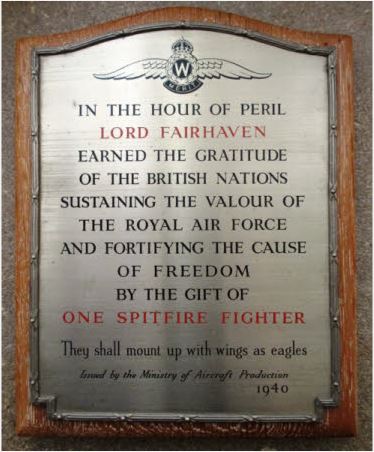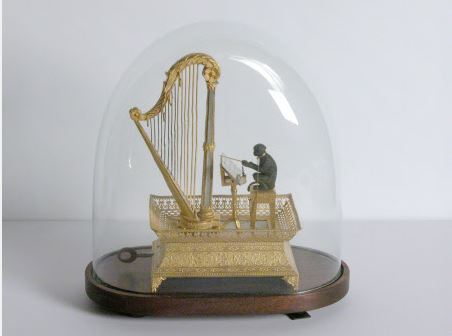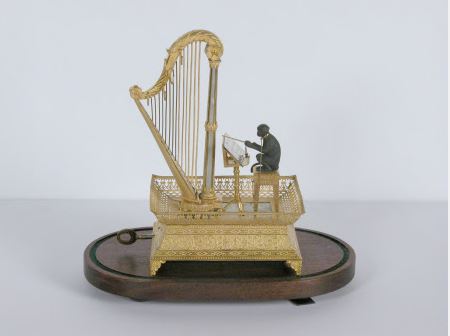This blog continues in the “Europe & the U.S. in 99 Objects” series. Dr. Gabriella de la Rosa at the National Trust has started this project for the National Trust, originally published here, by delving into the Trust’s collections – nearly 1 million objects held at over 200 historic properties across the United Kingdom – to find objects with interesting, unusual and unexpected connections to Europe. These objects and their stories are being published in the form of a digital diary on the National Trust Collections website.
#30 Plaque
Category: Objets de vertu
Date: 1940
Materials: Metal plaque on wood
Collection: Anglesey Abbey, Cambridgeshire (Accredited Museum)
On show at: Anglesey Abbey, Cambridgeshire, East of England, National Trust
NT 517669
Caption
During the First and Second World Wars, patriotic Britons donated funds to build fighter planes, sometimes banding together to name the plane after their hometown or village. This plaque commemorates the presentation spitfire donated by the 1st Lord Fairhaven, the immensely wealthy owner of Anglesey Abbey.
Fairhaven made the requisite £5,000 donation (approximately £300,000 in today’s money) in June of 1940, naming the Mark IIa P7736 ‘Cambridgeshire’. The following year, on 24 April 1941, Cambridgeshire took off from Tangmere airfield. It was piloted by Sergeant Thomas McDevette as part of a ‘rhubarb’ – an operation to attack German ground targets in France. McDevette was last seen strafing a German airfield near Cherbourg and neither his body nor the plane was ever recovered.
This plaque in the Library at Anglesey Abbey and Sergeant McDevette’s name on the RAF memorial at Runnymede remain the only tangible evidence of Lord Fairhaven’s generosity and, like so many of his countrymen, of McDevette’s supreme sacrifice.
Summary
Plaque commemorating Lord Fairhaven’s gift of a Spitfire to the RAF. Incription reads ‘In the Hour of Peril Lord Fairhaven earned the gratitude of the British Nations sustaining the Valour of the Royal Air Force and fortifying the Cause of Freedom by the Gift of One Spitfire Fighter. They shall mount up with wings as eagles. Issued by the Ministry of Aircraft Production 1940’.
#30 Automaton
Moulinie Aine and Co.
Category: Musical instruments, devices and recordings
Date: circa 1820
Materials: Ormolu, ebony, ivory, steel, mother-of-pearl, wood and glass
Measurements: 227 x 145 x 106 mm
Place of origin: Geneva
Collection: Attingham Park, Shropshire (Accredited Museum)
On show at: Attingham Park, Shropshire, Midlands, National Trust
NT 608416
Anthropomorphic animals can be quite mesmerizing, but what can be said about the chained monkey perched within this ormolu music box made in Geneva in the early 19th century? The music box is actually an automaton equipped with an intricate mechanism that enables the monkey to turn his head while conducting music with an ivory baton.
The music that is played is an example of a traditional Swiss melody known as a ‘Ranz des Vaches’. Melodies like this were played on horns by Alpine herdsmen to coax their cattle to be milked or to move up the mountains. So evocative of Switzerland were these melodies that Swiss soldiers in French regiments were forbidden under penalty of death from singing them, lest the tunes might encourage desertion. Today, the nostalgia-inducing melody can be heard playing in the Sultana Room at Attingham Park.
Summary
Ormolu musical box automaton made by Moulinie Aine and Co. of Geneva, Switzerland, circa 1820. Chained ebony monkey seated before harp and music stand. His head turns as he conducts music with an ivory baton. Sheet music engraved ‘Ranz de Vaches Air de Figaro’. Moulinie Aine and Co a Geneve (maker’s name engraved on steel sheet music). Chased ormolu mounts to mother-of-pearl base. Housed in its original glass dome with oval wood base. Traditionally believed to be a gift to Sophia, wife of the 2nd Lord Berwick.
Visit these objects and more when you become a member.






